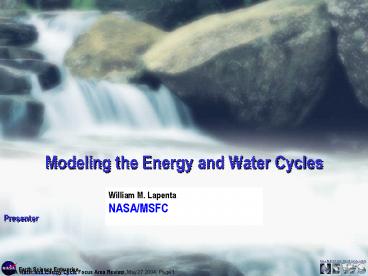Modeling the Energy and Water Cycles - PowerPoint PPT Presentation
1 / 12
Title:
Modeling the Energy and Water Cycles
Description:
Aries/GEOS. Atmos. GCM. Earth Science Enterprise. Earth Science Enterprise ... Characteristic Length Scale (km) Characteristic Time Scale (s) Meso. Planetary ... – PowerPoint PPT presentation
Number of Views:31
Avg rating:3.0/5.0
Title: Modeling the Energy and Water Cycles
1
Modeling the Energy and Water Cycles
William M. Lapenta NASA/MSFC
2
NASA ESE Conducts Observation Driven Modeling.
- NASA satellite observations characterize
variability at seasonal-to-interannual timescales
and provide information to initialize and
validate forecasts using coupled models. - Satellites are the sole source of Global sea
surface temperature, surface winds, surface
height, precipitation and soil moisture. - NASA leads the development in optimal use of
these data for analysis and prediction.
3
Models are a Common Thread to Science Areas
Water and Energy Cycle Climate Weather
Strong links between
4
Challenges to be Engaged by NEWS
- Cycles inherently linked
- Spatial and temporal gaps between explicit and
implicit representation of processes - Clouds and precip (microphysics)
- Radiative forcing
- Land/Ice Hydrodynamics
- 3D transport and structures in oceans and
atmosphere - Aerosol feedbacks
- Requires complex coupling on model systems
- Regional climate impacts require high resolution
and greater skill at subseasonal timescales - Prediction of extreme weather events requires
large ensembles
- Availability of altimetry and adequate soil
moisture data, precipitation data - Forecasts at subseasonal timescales requires
assimilating cloud and precipitation data
5
Earth System Models
6
Scales of Concern..
Global Climate Models
Limited Area Mesoscale Models
Cloud Resolving Models
Large Eddy Simulations
Characteristic Time Scale (s)
Meso
Planetary
synoptic
Convective
Micro
Characteristic Length Scale (km)
7
Modeling and the Water and Energy Cycle Road Map
Goal at the conclusion of phase 3 (2018)
Conduct and enable improved, observationally-based
, predictions of energy and water cycle
consequences of Earth system variability and
change.
Phase 1 Exploiting Current Capabilities
Outcome 2008 Systematic evaluation of existing
prediction system components
TRMM
TERRA
AQUA
GRACE
AURA
Quantitative evaluation
CALIPSO
CloudSAT
Advance existing parameterizations
iceSAT
Advanced Model Dynamics
Develop explicit coupled models
Advanced Data Assimilation
8
Modeling and the Water and Energy Cycle Road Map
Goal at the conclusion of phase 3 (2018)
Conduct and enable improved, observationally-based
, predictions of energy and water cycle
consequences of Earth system variability and
change.
Phase 2 (2009) Address deficiencies and build
system
Outcome 2013 Foundation and first floor of
prediction system well established
GPM
HYDROS
AQUA
AQUARIUS
GRACE
AURA
explicit coupled models become more robust
CALIPSO
Ensembles to quantify uncertainty
CloudSAT
iceSAT
Complex RT codes now efficient
Systematic testing of system
Coupled Data Assimilation
Super parameterizations
9
Modeling and the Water and Energy Cycle Road Map
Goal at the conclusion of phase 3 (2018)
Conduct and enable improved, observationally-based
, predictions of energy and water cycle
consequences of Earth system variability and
change.
Phase 3 (2014) Address vision and deliver system
Outcome 2018 End-to-end Prediction system with
advanced understanding of uncertainty
TRMM
BLsat
AQUA
GRACE
AURA
Predicting consequences of climate change
CALIPSO
CloudSAT
4D fully coupled data assimilation
iceSAT
Demonstrate utility of predictions
Conduct systematic testing of past 30 to 50 year
record
10
Required Technology
- SOFTWARE TOOLS
- ESMF extensions
- Flexible model components
- Full support for DA
- Integrated model environ.
- Analysis/visualization tools
- Data management S/W conforming to community code
data structure standards
- High-end computing driven by
- spatial and temporal resolution requirements
- Fully coupled components
- Data assimilation
- Platform optimization
- Information synthesis associated with large data
sets - Data mining, Fusion, Visualization
- Rapid access and dissemination of data
- Data access and dissemination
- Rapid assess
- Access to subsets
- SOFTWARE TOOLS
- 1st phase ESMF
- Interchangeable compts
- ODA support
Phase 1
Phase 2
- DATA MANAGEMENT
- Virtual data archive
- 25PB distributed archive
- Fast access to remote 30TB
Phase 2
- DATA MANAGEMENT
- Distributed archives
- Manually generated catalogs metadata
Phase 1
11
Summary
12
Summary Cont.
- NASA must build on strengths
- Comprehensive observation-based Earth modeling
(bottom of ocean to top of atmosphere) - Advanced data assimilation
- Advanced computing Computing capacity, modernize
increase
- Required Missions
- Fly HYDROS (soil moisture to initialize land
surface) - Fly GPM (precipitation obs essential to
initialize subseasonal timescale) - Fly OSTM/WSOA (eddy heat transport global sea
level rise, upper heat content) - Fly AQUARIUS (salinity is one key of slow THC)
- Fly MEOSCAT (wind maintains the THC, not just
density increase at high lat) - Fly ICESat-n, decadal change in ice volume,
freshwater input to ocean - Fly a SEA ICE THICKNESS mission (ICESat-n, IIP ?
ESSP),

